How to Make Ricotta From Whey
This post may contain affiliate links, view our disclosure policy for details.
In this post, we will learn how to make ricotta from whey. After making cheese, we are left with a good amount of whey, making ricotta from it is simple and quick. This homemade ricotta from whey is delicious and very simple to make!
There are many things you can do with the whey that is left after you make cheese at home. Honestly, I usually do one of two things… I either give it to the animals or use it when making bread as a replacement for the water in the recipe. Recently, I found out that before I use it for those things, I can make one more kind of cheese from it — Ricotta.
This recipe is good whether you are using store-bought milk or raw milk, goat milk, or cow’s milk… I am using my raw goat’s milk to make most of my homemade cheeses and in this post, I’ll be using the whey from this milk to show you how to make ricotta from whey.
How to Make Ricotta From Whey…
It takes some serious effort to keep goats (I raise Lamancha goats) alive here in NC. I am not sure if everyone all over the country experiences this but here in NC goats die like flies. We have very hot and very humid summers. The perfect ground for so many parasites. Not only are they abundant, they are also aggressive and very resistant to medications.
Anyway, this is a topic for another post, but what I am trying to say is that when I do get delicious goat milk from my goats, you can bet that I am going to do the best I can to use it to the fullest. Here are some of the ways that I use my goat milk…
- Make goat milk soap
- Make feta cheese
- Make soft, spreadable cheese
- Make hard goat cheese (a recipe that I’ve learned in the mountains of Israel!)
- Make yogurt
- And I also can my milk!
What Kind of Whey Can Be Used…
You can use whey from goat’s milk, cow’s milk, sheep’s milk… However, This ricotta can only be made from whey that was produced from making cheese without acids like vinegar, lemon juice, or citric acid. If you used vinegar to make your cheese, your cheese produced whey, and you are here trying to follow this recipe to make ricotta, this will not work. Take a moment to read some of the comments below… Lots of people tried this, some with success and some not so much. After a few years, that’s the conclusion we came to.
What is Ricotta Cheese…
Ricotta cheese is a creamy, white, mild, and soft texture cheese. Traditionally, Italian cheese makers made ricotta from whey left behind after making Mozzarella or Provolone cheese. Ricotta consists of delicate granules that are moist and is very rich in calcium.
You can use ricotta cheese in pasta, especially filled pasta like lasagna, ravioli, and tortellini. You can season it and add it to salads or sandwiches, and it is so good as a dessert with some honey, fruit, chocolate, or jam.
Tools That We Are Going to Need…
- Stainless pot – it’s best if it’s a heavy bottom pot so the whey doesn’t scorch when we heat it.
- A slotted spoon – or another stainless spoon for stirring the whey.
- A cheese thermometer – or any other kind of thermometer that can read to 200 degrees F.
- 1/4 cup measuring cup – to measure the vinegar.
- A colander – or you can use a strainer or a bowl. We will line it with the cheesecloth before we hang the cloth. If you don’t want to catch the whey then you can use a strainer or a colander and place it in the sink.
- Cheesecloth – let me tell you a secret… You don’t need a fancy cheesecloth! Your local Walmart sells a pack of five or so flour sack tea towels for something around $5. I am linking to a “proper” cheesecloth in case you are not sure what a cheesecloth is. The flour sack towels that I get at my local Walmart work better than a cheesecloth in my opinion and they are so cheap! It’s all you need. Also, make sure to have a string of some sort (I use yarn) to tie and hang the cheesecloth with.
For a comprehensive list of cheesemaking equipment and ingredients, make sure to visit my cheesemaking equipment post. Ok, we are ready to go through this ricotta from whey tutorial. You’ll find all the steps below, however, if you want to have a better understanding of the cheesemaking process, please visit my How to Make Cheese at Home post.
Ingredients…
- Whey
- Vinegar – apple cider or white. In this tutorial, I used my apple scrap vinegar.
- Salt – sea, cheese, or Kosher
Making Ricotta From Whey…
Step one – heat the whey. Add the whey to a heavy-bottomed pot, and set on the stovetop. Turn the heat to medium and slowly heat the whey to 195 degrees Fahrenheit while stirring frequently so it doesn’t scorch.
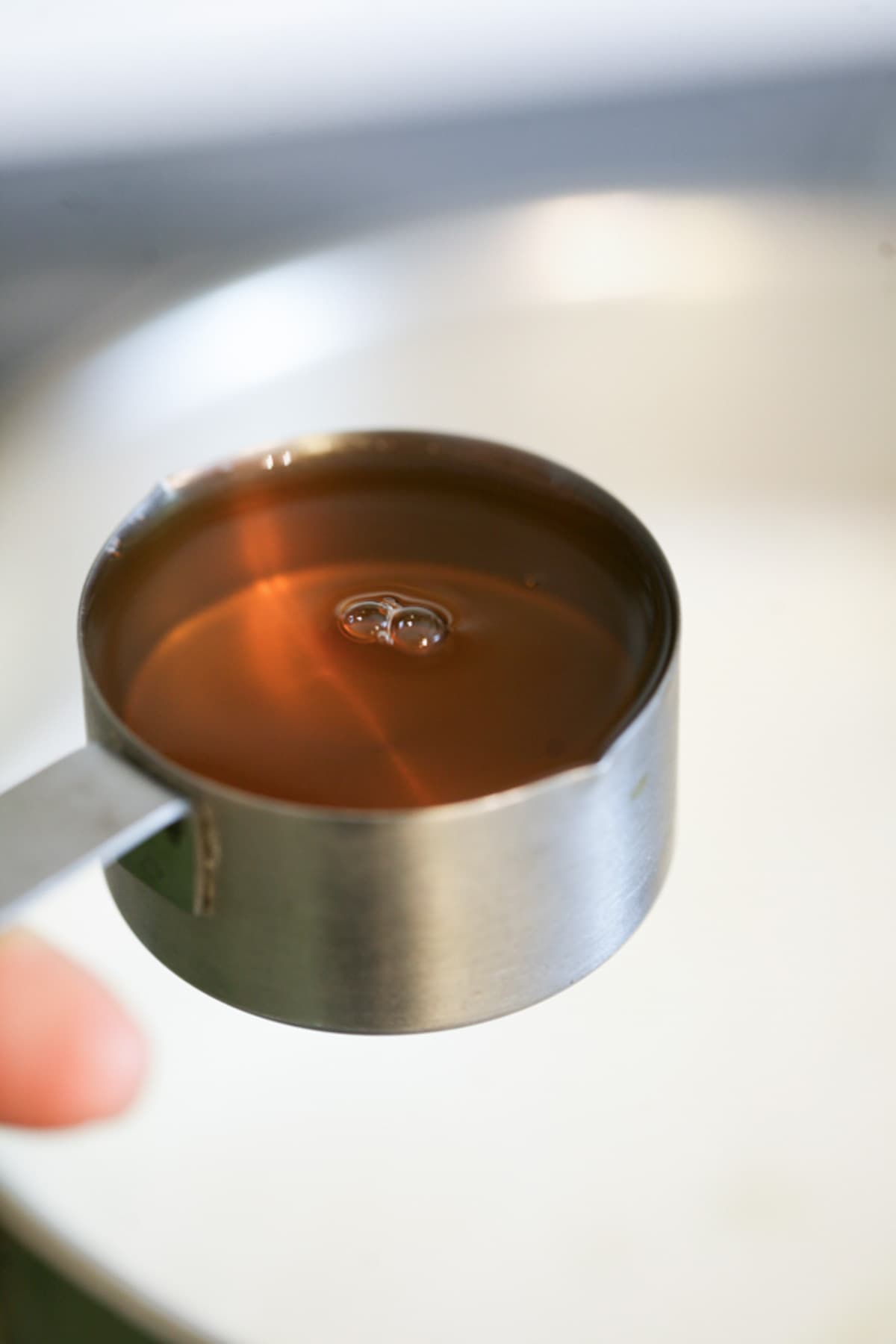

Step two – add the vinegar. Remove the pot from the heat and add the vinegar. Stir it in for a minute or so. You’ll see that the whey starts to curdle. Let it sit for a few minutes.
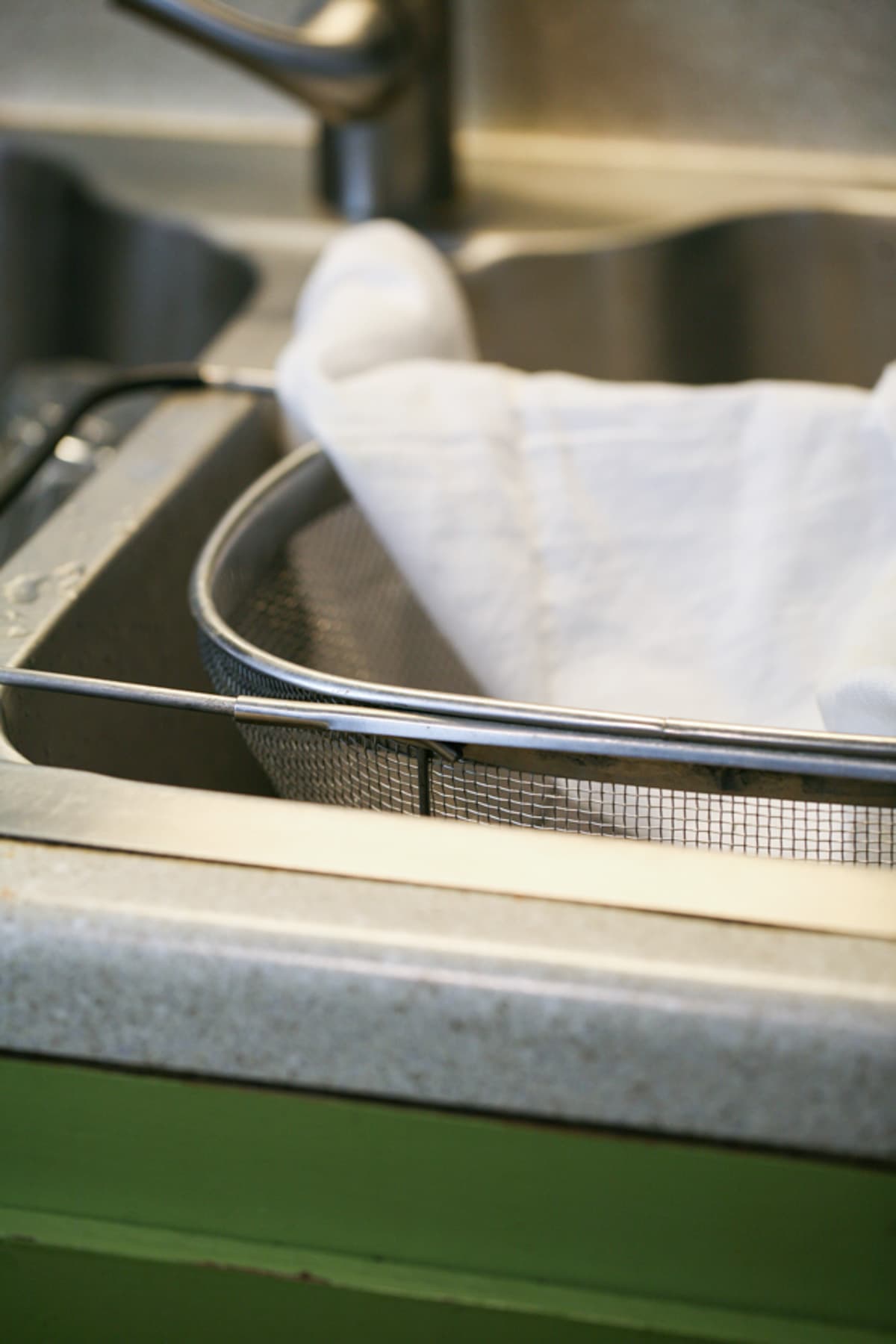
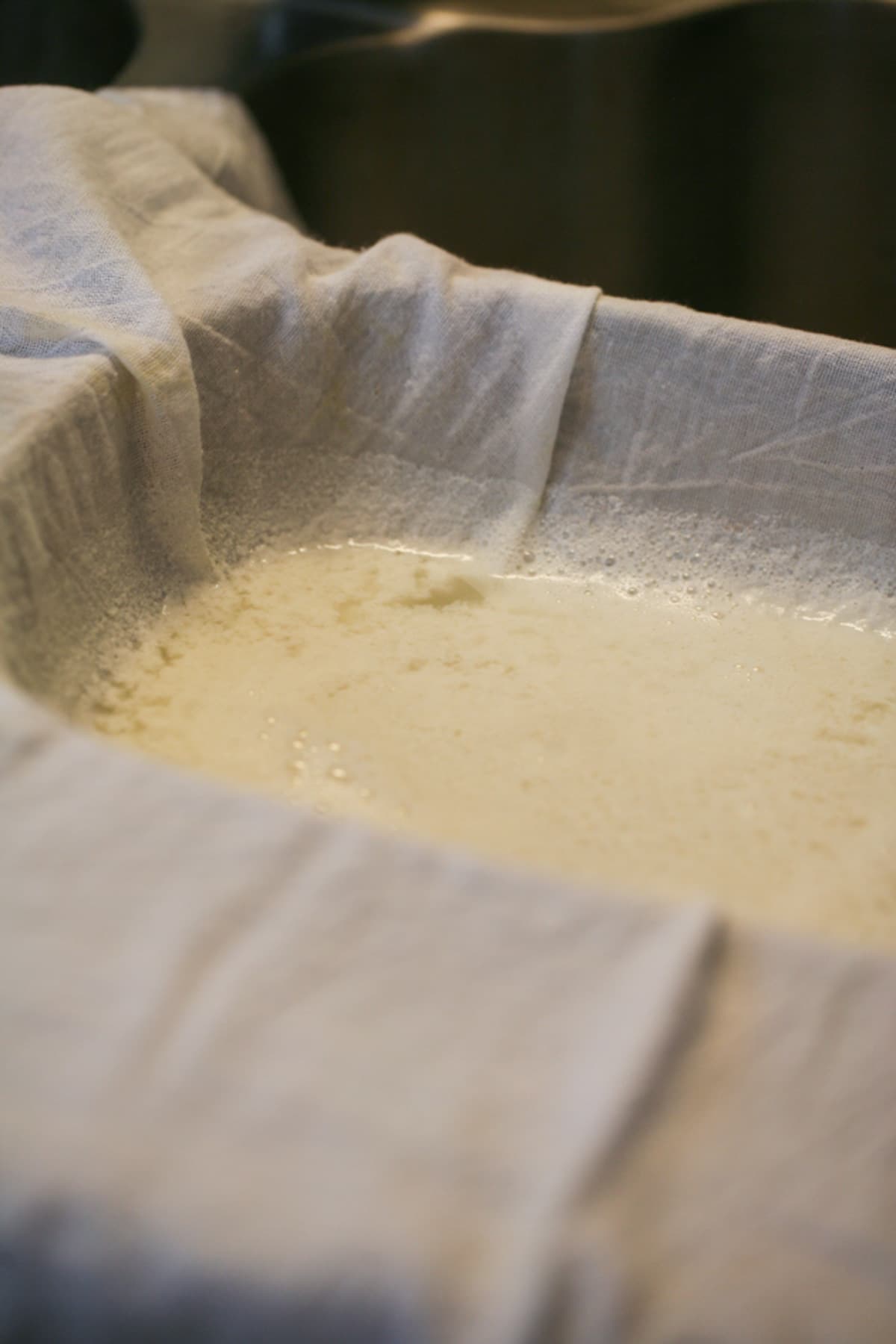
Step three – strain the whey. Place a strainer over the sink or over a bowl if you want to catch the liquid and line it with a cheesecloth or a flour sack towel. Pour the curdled whey onto the flour sack and let the liquid drain for a few minutes.
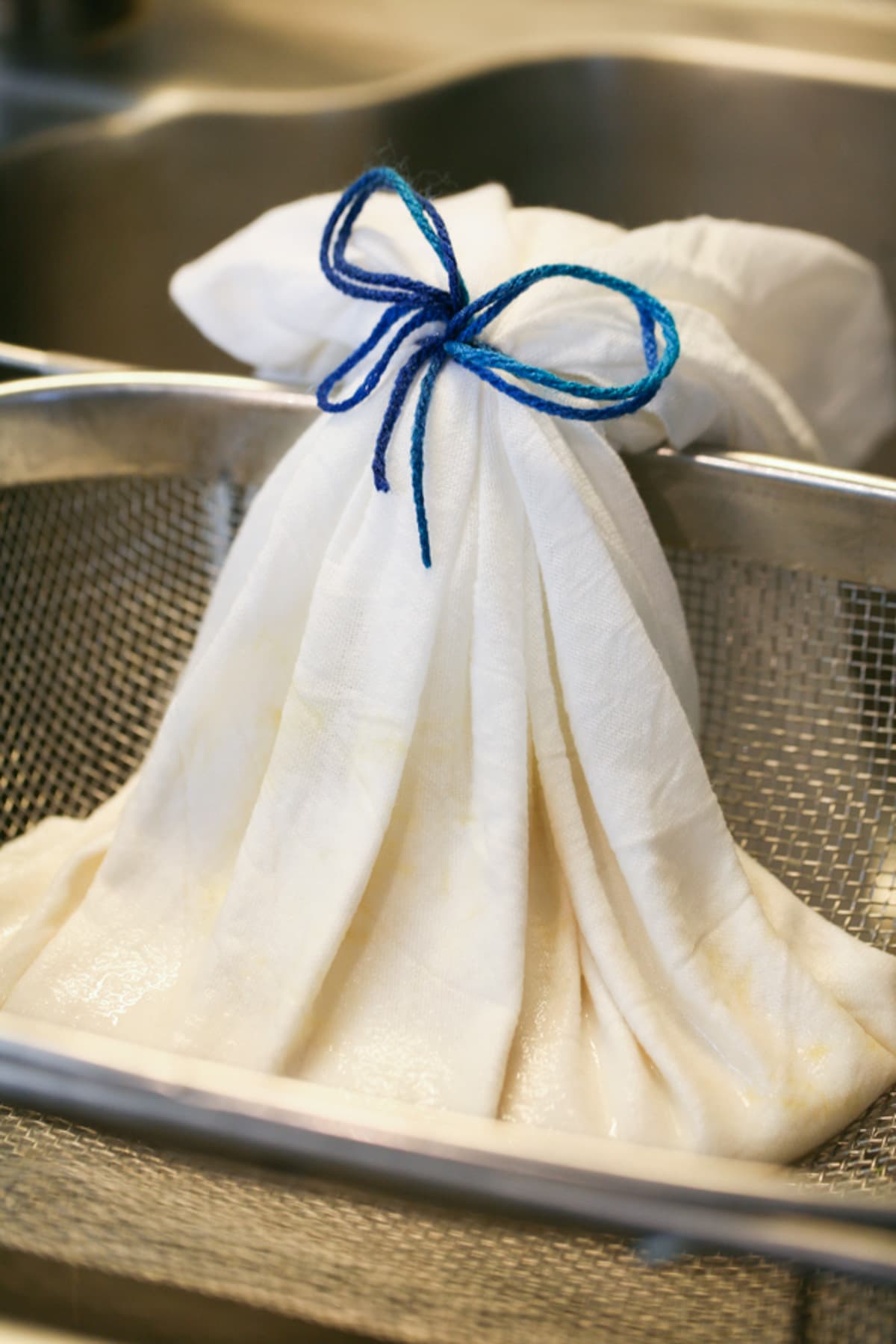
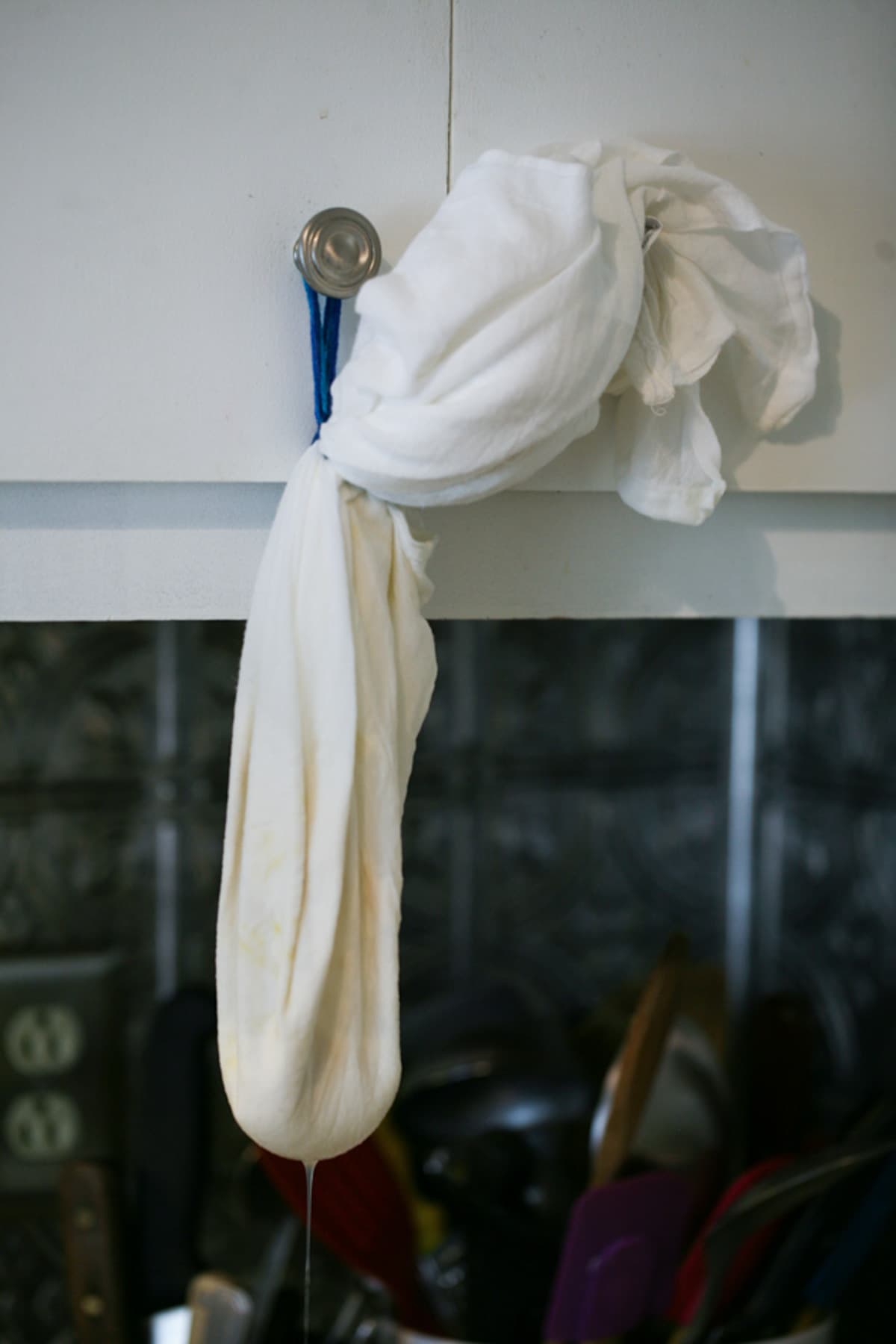
Step four – hang. Gather the ends of the flour sack and tie them. Then hang the flour sack on one of your kitchen cabinets with a bowl underneath it to catch the remaining whey. Depending on the amount of whey you are processing, you might need to leave the bag hanging from one hour to five or six or seven hours.
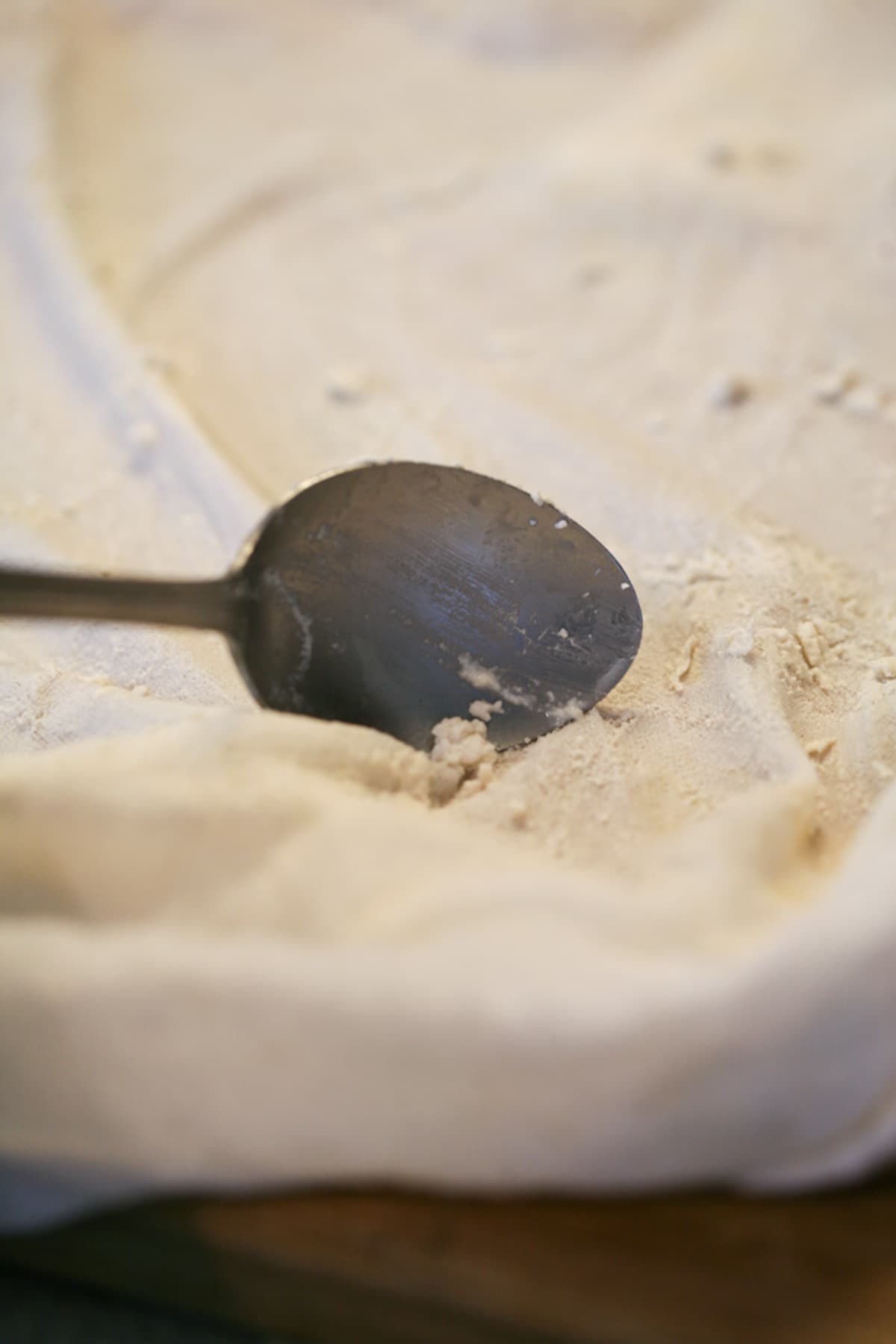
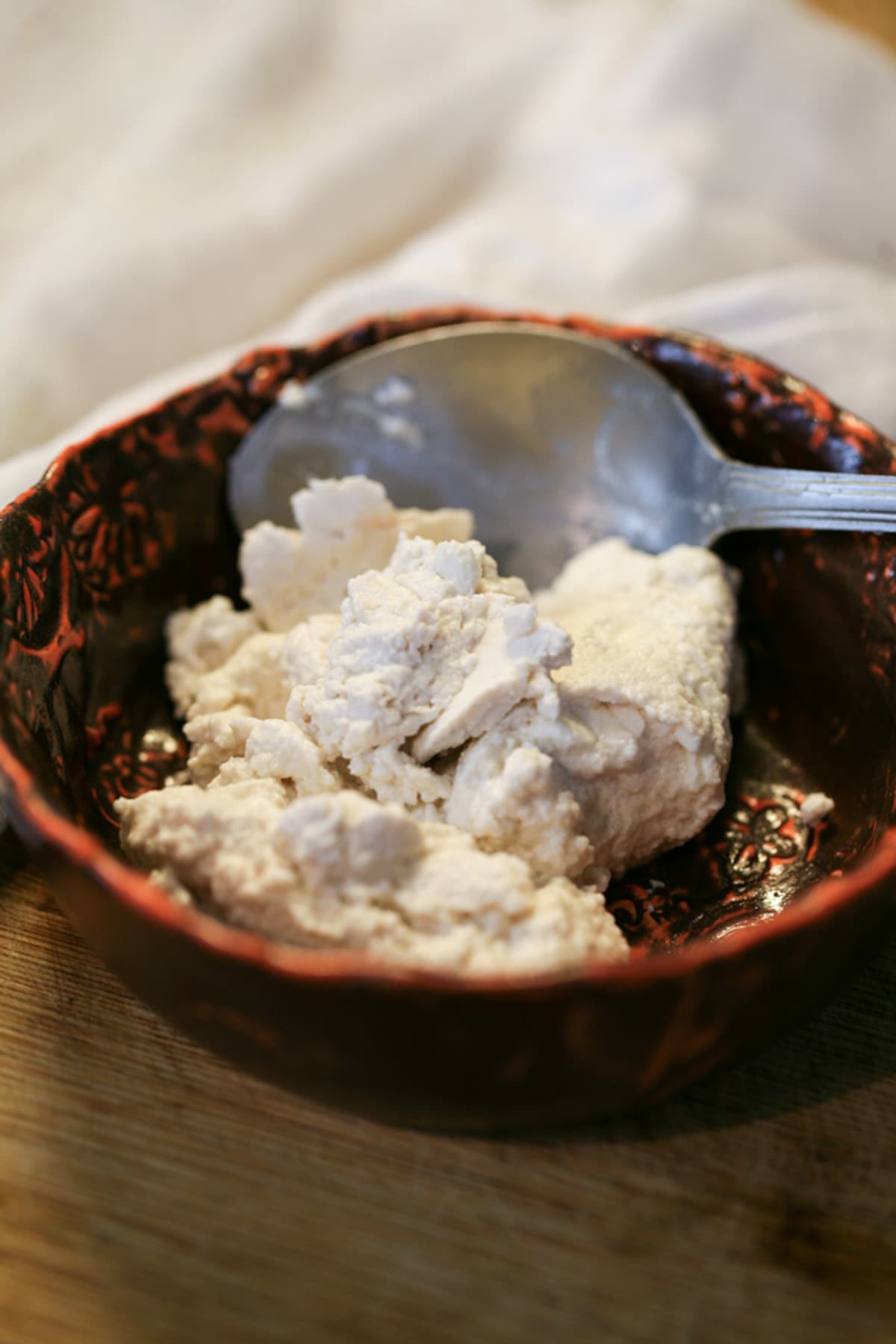
Step five – remove the cheese from the flour sack. Open your flour sack and use a spoon to scrape the soft ricotta into a bowl.
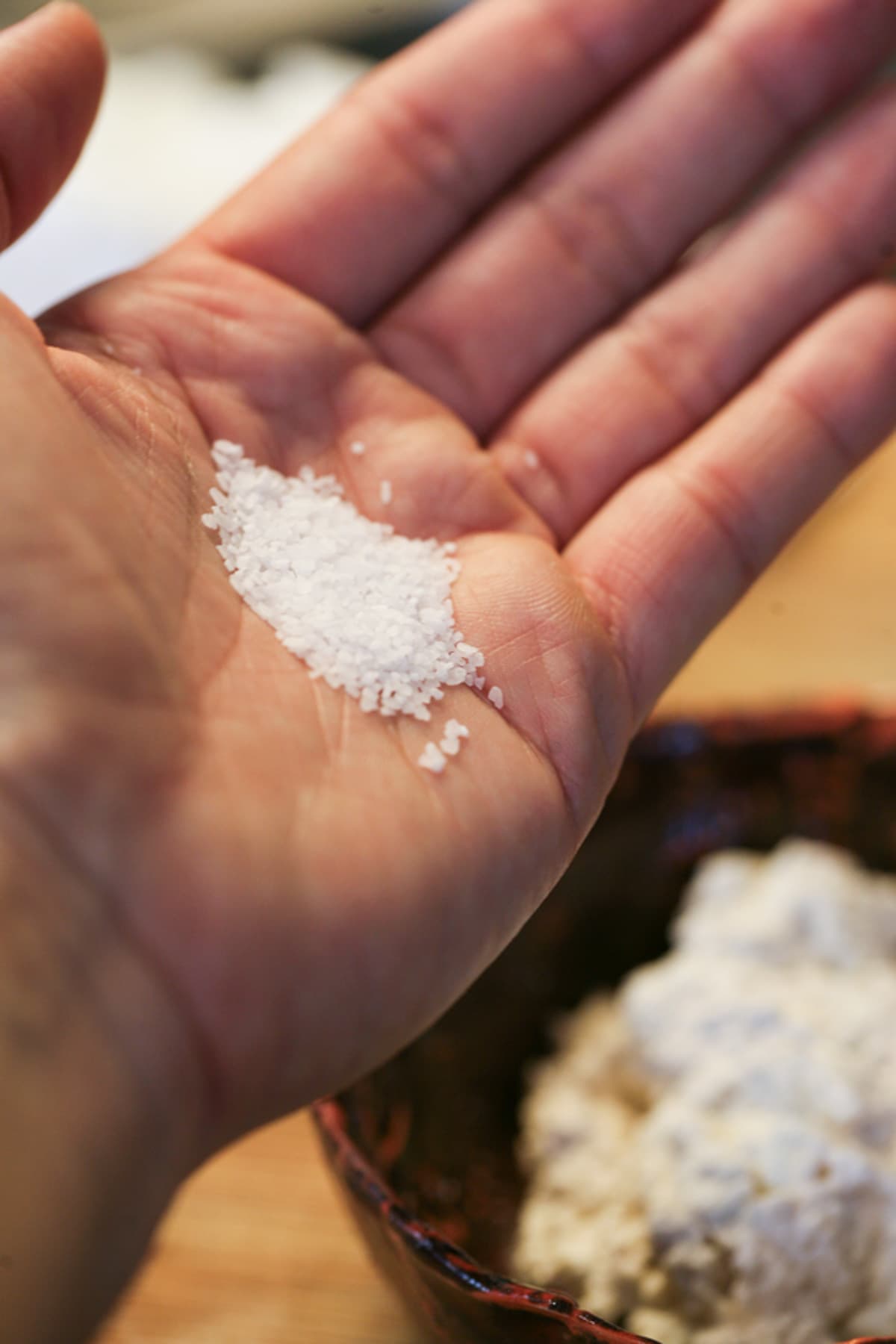
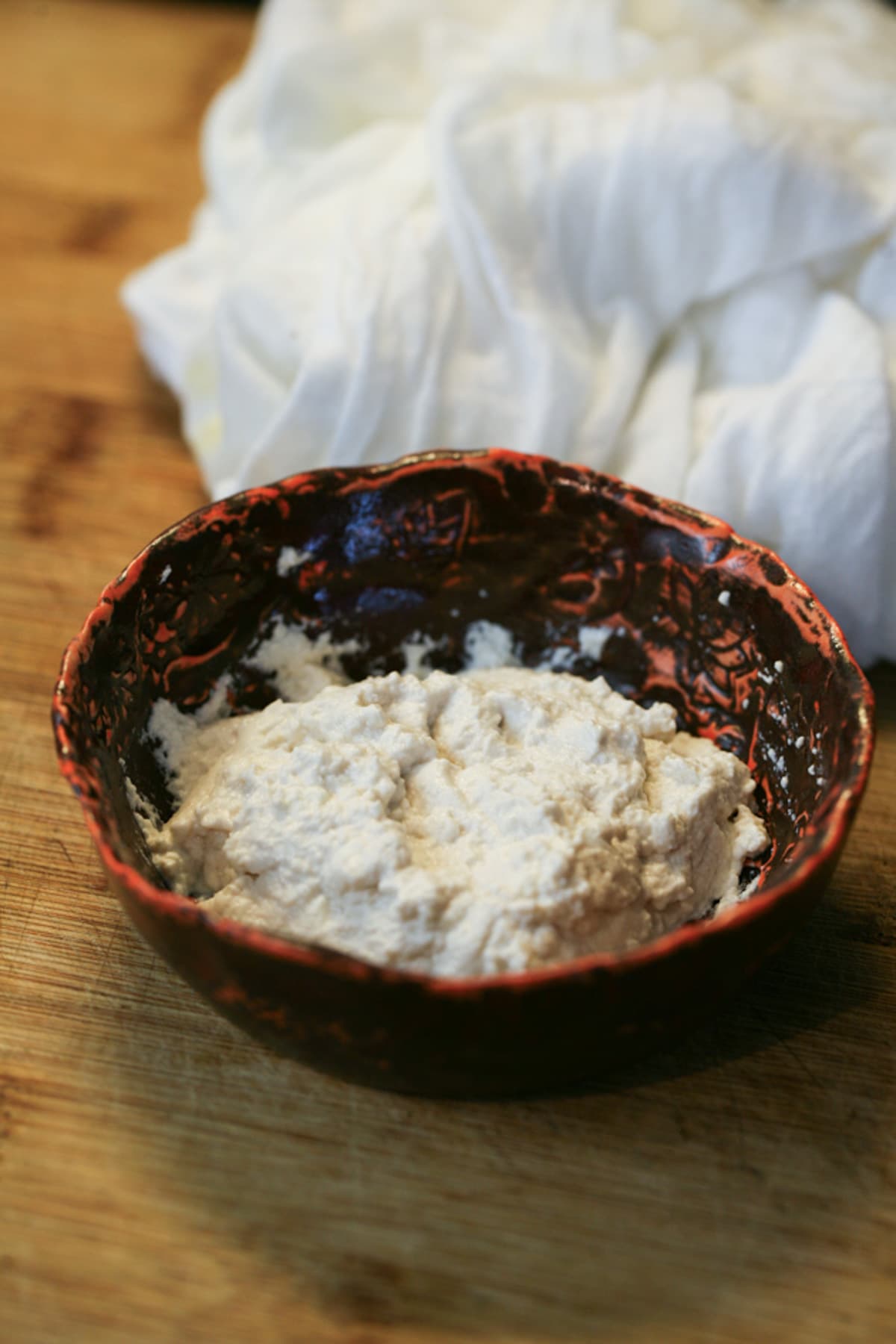
Storing Your Made from Whey Ricotta Cheese…
Before you store your cheese, salt it to your taste. Remember to use non-iodized salt. Sea, Kosher, or cheese salt will do. Mix the salt well into the cheese. Add the cheese to an air-tight container and store it in the fridge.
Serving…
Your made-from-whey ricotta cheese can be served right away, however, like every homemade cheese, it will benefit from a bit of curing in the fridge (24 hours or so should be enough). You can serve and use this ricotta cheese just as you would use any ricotta cheese that you purchase at the store.
Frequently Asked Questions…
Yes. If you make cheese and don’t have time to process the whey right away, feel free to keep it in the fridge for a day or two. Then take it out and heat it according to the recipe.
I’ve never tried but I think that it should freeze well.
You can use the whey leftover after making ricotta from whey to cook with or for baking if it’s not too vinegary for you. You can also add it to healthy smoothies or give it to your animals.
I’ve never tried it but I think that it should work.
Yes, as long as you used your store-bought milk to make cheese without using acids.
Please take a moment to read through the comments below. I make this cheese after making my feta cheese and it always works. It’s creamy and just a bit salty and even though I don’t like ricotta and never buy it at the store, I do love this ricotta! Please comment below and let us know if this worked for you.
Try Pairing this Ricotta Cheese With…
- Sweet Pepper Paste
- Basil Pesto
- Garlic Scape Pesto
- Add it to this Zucchini Casserole
- Use it in these Spinach Patties
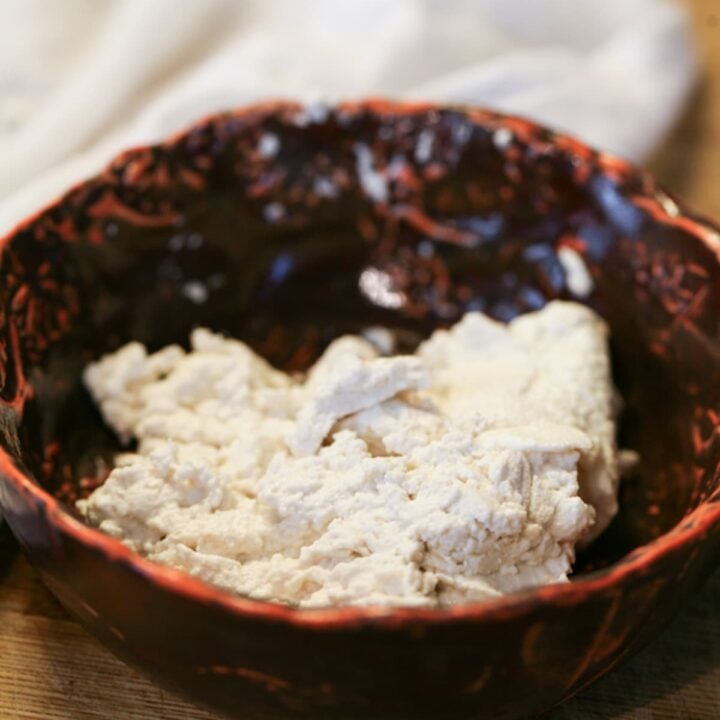
Ricotta From Whey
Delicious ricotta from whey. This ricotta is delicious and easy to make.
Ingredients
- A gallon of whey
- 1/4 cup vinegar (apple cider or distilled white)
- 1/2 teaspoon cheese salt or kosher salt
Instructions
- Heat the whey to 195 degrees Fahrenheit over medium heat. Stir constantly to prevent scorching.
- Remove from heat, add vinegar, stir and set aside for a few minutes.
- Line a colander with cheesecloth, add the whey. Let it drain a couple minutes.
- Collect the ends of the cloth, tie them, and hang to drain anywhere from one hour to a few hours depending on how much whey you are processing.
- Remove the ricotta from the cheesecloth and salt to taste with sea, cheese, or kosher salt.
** This ricotta can only be made from whey that was produced from making cheese without acids like vinegar, lemon juice, or citric acid. If you used vinegar to make your cheese, your cheese produced whey, and you are here trying to follow this recipe to make ricotta, this will not work.
Notes
Frequently Asked Questions...
- Can I keep my whey in the fridge?
Yes. If you make cheese and don’t have time to process the whey right away, feel free to keep it in the fridge for a day or two. Then take it out and heat it according to the recipe. - Can I freeze this ricotta cheese?
I’ve never tried but I think that it should freeze well. - Can I use the leftover whey?
You can use the whey leftover after making ricotta from whey to cook with or for baking if it’s not too vinegary for you. You can also add it to healthy smoothies or give it to your animals. - Can I use whey that was previously frozen?
I’ve never tried it but I think that it should work. - Can I use whey from store-bought milk?
Yes, as long as you used your store-bought milk to make cheese without using acids.
Nutrition Information:
Yield: 6 Serving Size: TablespoonAmount Per Serving: Calories: 60

Hi! I’m Lady Lee. I help homesteaders simplify their homesteading journey while still producing a ton of food! I am a single mother of four, I was born in Israel and raised in an agricultural commune called a Kibbutz. Now I homestead in central NC.


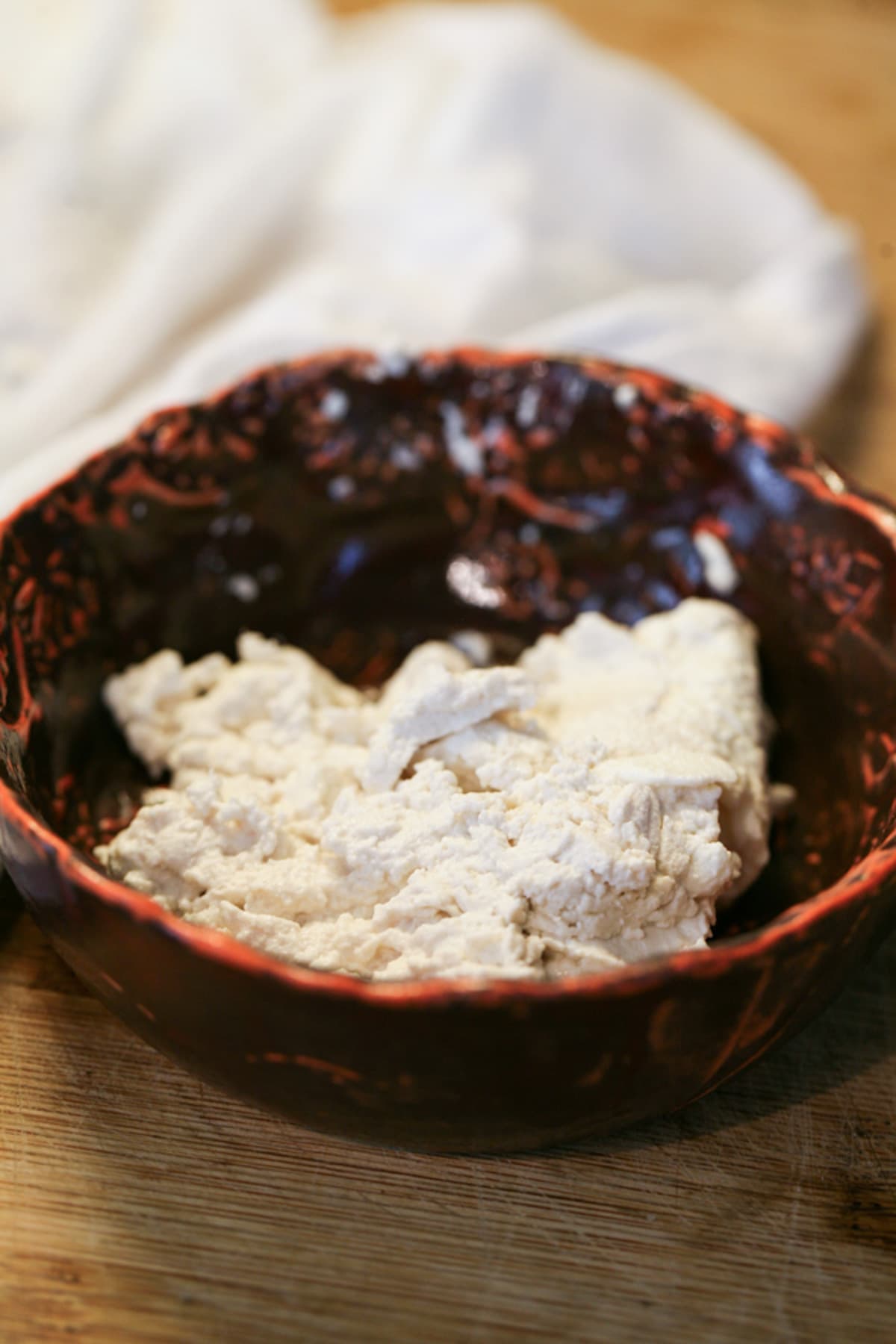
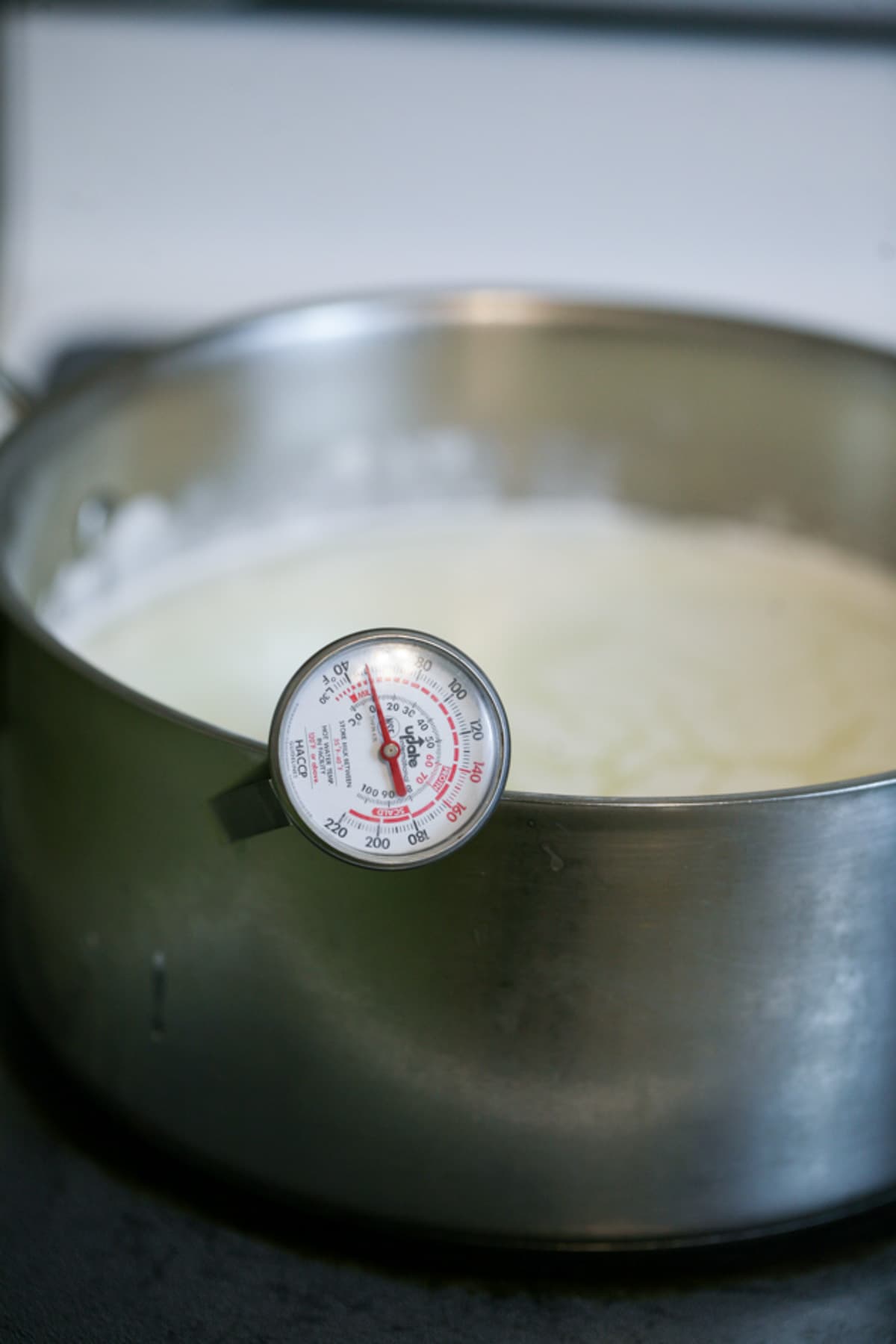
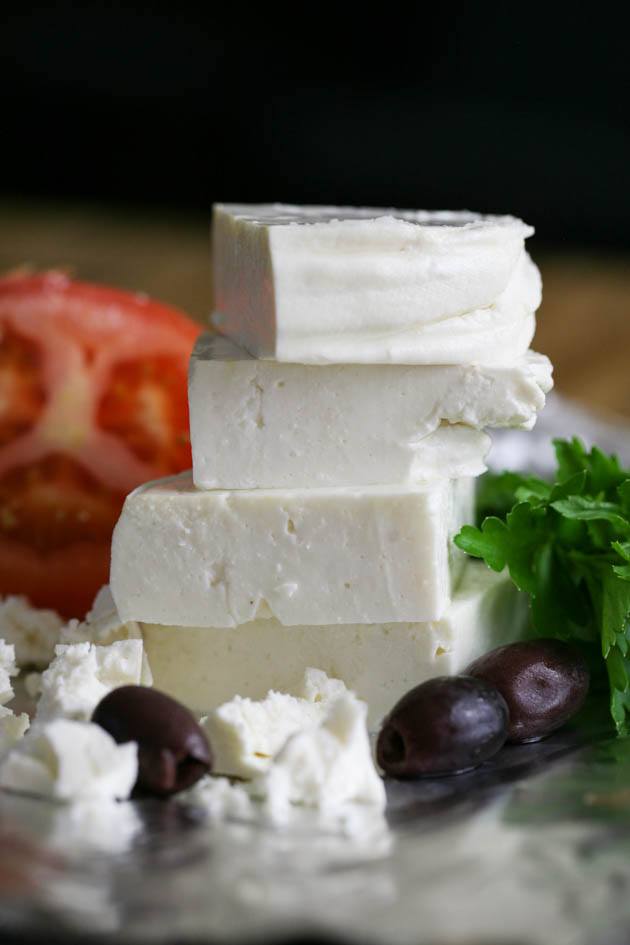
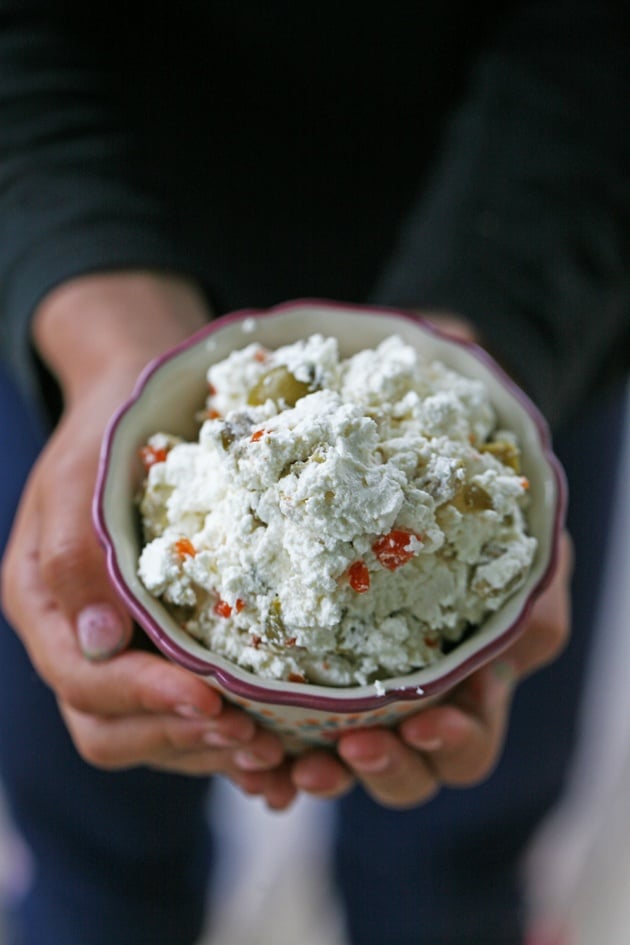
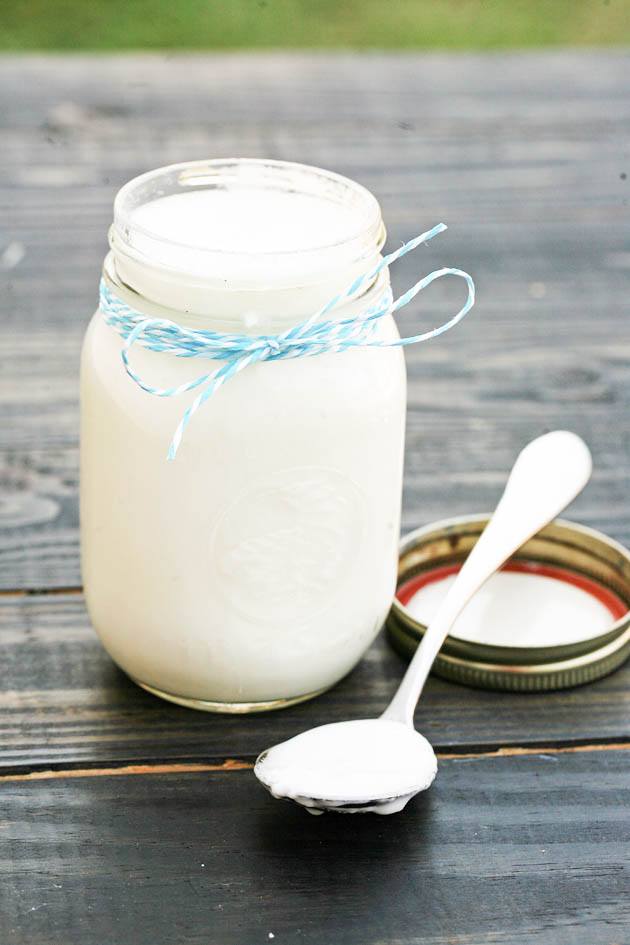
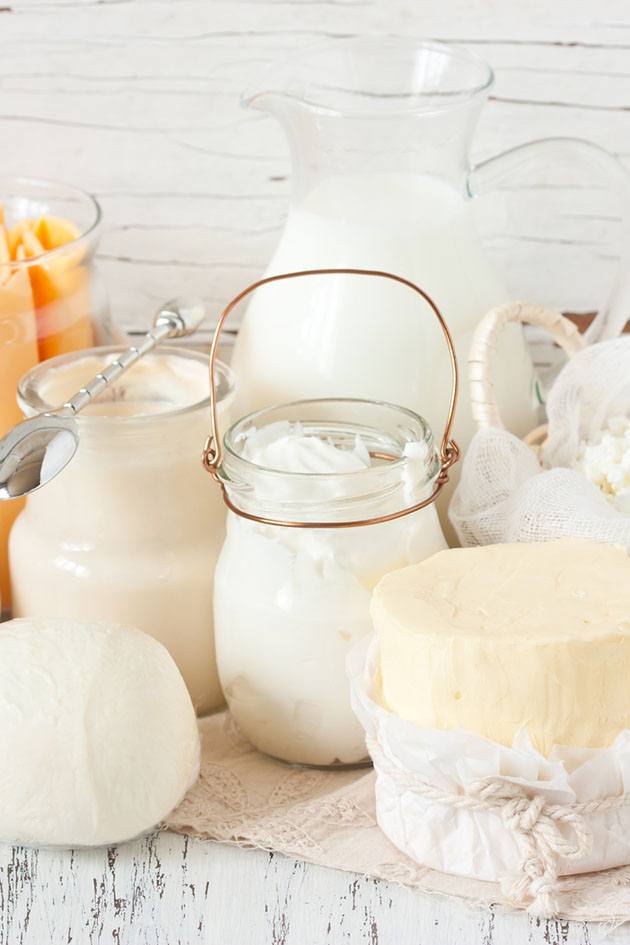
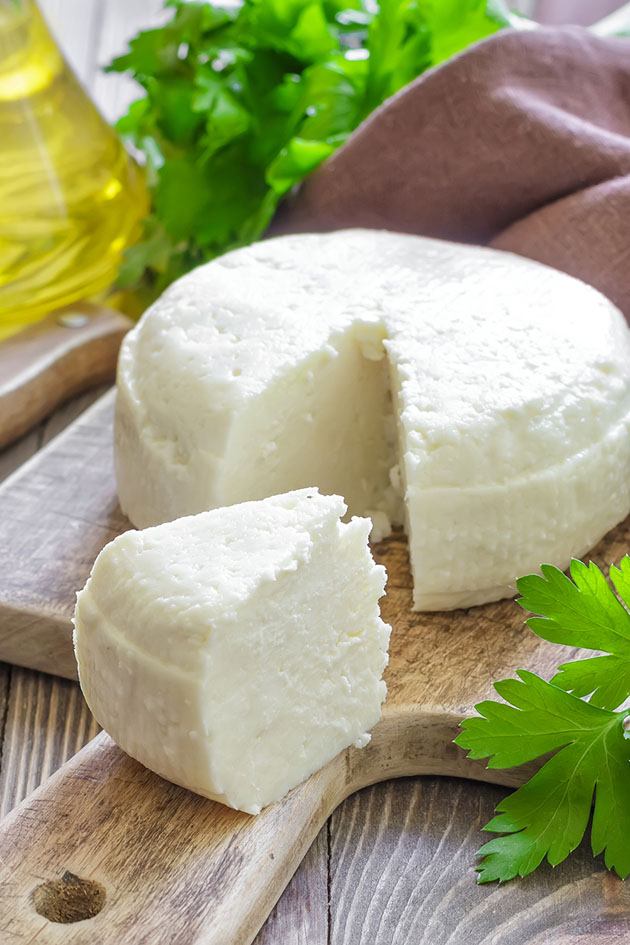
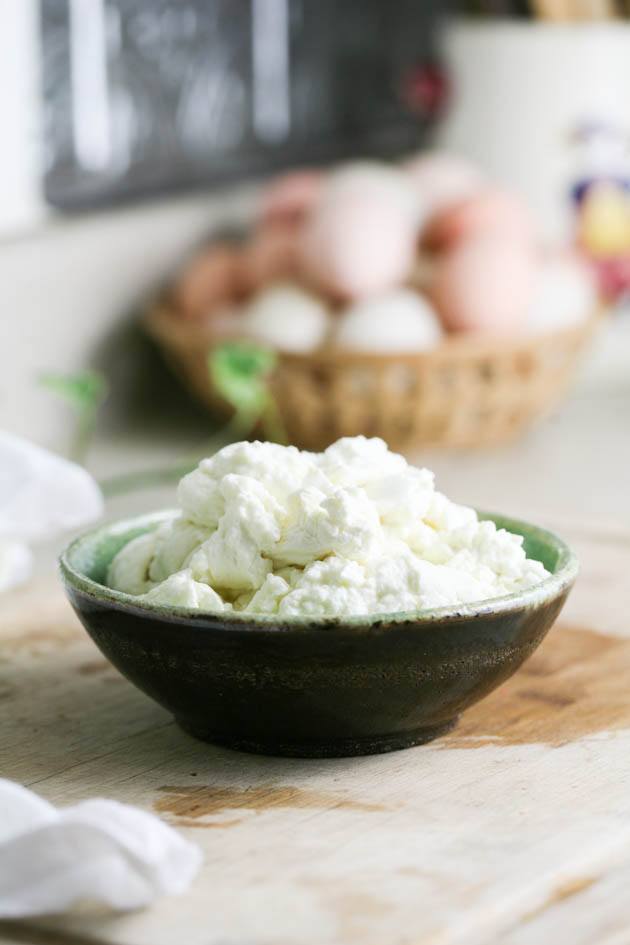
Tried it. Did not work on my whey. I make tvorog ( farmers cheese). I use a small portion from previous batch to help the new batch go sour at room temp for 2 days. I don’t add anything else. The vinegar trick did not curled the whey.
can I make ricotta cheese from farmer’s cheese whey of which I used sour cream to sour the milk?
I’ve never tried but I think that it might work since you didn’t use acid to make the farme’s cheese.
What do you use instead of vinegar? Just made my first batch of cheese, looks pretty good. Thanks to everyone!dianna
You mean when making cheese? For most cheeses I use rennet and cultures. Some kinds of cheese are made with acid, like lemon juice or vinegar, but not all.
so I guess I did something wrong…. I started put making farmers cheese using raw cow milk and vinegar. my whey looked yellow.any way followed the directions to the letter but no ricotta formed. ????
It won’t work if you previously used vinegar. From all the comments and the people that have tried this I’ve gathered that it only workes if the whey comes from a cheese that was made with rennet and not an acidic ingredient like lemon juice or vinegar. I just didn’t get to update this post yet. I’ll go add a quick update now and hopefully I can update the whole thing soon.
This turned out perfectly for me. I followed these directions perfectly to get my whey: https://ladyleeshome.com/homemade-feta-cheese/
And then I followed the instructions above perfectly.
Thank you again for another successful recipe.
Yes, when it comes to this way of making ricotta, it seems like it depends on the cheese you make before you try this. I think that I also got the whey for this tutorial from a batch of feta cheese I made. Glad it worked!
Hello, I made farmers cheese from my goats milk and then with the leftover whey tried to make ricotta using white vinegar. Nothing happened…. too bad.
I hate to join the bandwagon, but I must say that it did not work for me either. But that’s okay, I’m glad it works for you and I will find another use for my left over whey.
Made this using leftover whey from making butter. Simple and super tasty!
This is a waste of time. It totally didn’t work. I used the leftover whey from making yogurt with whole grass fed milk. When I put the vinegar in, absolutely nothing happened. Bummer.
What did you use to make the yogurt? I need to update the post but from what I learn from other readers it only works with whey that comes from cheese that wasn’t processed with vinegar or lemon juice before.
Didn’t work for me… used whey strained out of Greek yogurt. made the yoghurt with milk and Greek yoghurt culture
This did not work for me, either, but I didn’t label the whey, so don’t know if it was from lemon juice, or vinegar. Note to self!
What can I do with this “double acid “ whey, now? Besides the compost pile?
If you have animals they should love drinking it. Other than that, it might be too acidic for anything else…
The ricotta making from the whey used to make cheese with vinegar did not work for me either.
I will try next time using lemon instead . Maybe that will work .
Will try to reuse the whey for something else .
Thanks for your recipe .
I think that it only works if the whey came from a cheese that was made with rennet and culture. If the cheese was made with vinegar or lemon then the whey ricotta is not going to work. That’s based on a lot of other comments. I have to update the post, just didn’t get to it yet.
I made fresh mozzarella earlier, with rennet, citric acid & calcium phosphate. How I learned to make it in culinary school. I used the whey and attempted to make ricotta, it didn’t work. Trying to figure out what went wrong. Sounds like people have had similar experiences.
I’m guessing it’s the citric acid. It seems like if you try this with whay that is a product of a cheese made with some sort of acid, like vinegar or citric acid, it doesn’t work. When I make it with whay that is a product of feta cheese, for example, it works well.
After a few years of people trying and commenting on this post, this is the conclusion I got to. I have to find time to update the post. Thanks for stopping by!
I make my mozzarella cheese with fresh milk and vinegar. the cheese turns out beautiful. I then heat the whey to 195 and add vinegar. everything dissolves and then I have a liquid, no ricotta. is it because I use vinegar to make mozzarella instead of of rennet and citric acid?
Yes. I believe that it will only work if you do it with whey that wasn’t a result of cheese made with vinegar previously.
I used a high quality whole milk to make ricotta cheese and thought that I would try to make more with the whey after seeing this recipe. All that I ended up with just the whey that I started with. I wasted a lot of time and got nothing for my efforts.
I’m sorry it didn’t work for you. It works for some and not for others for some reason. I think that it has to do with the ingredients that we use in the first cheese, the one that produces the milk but I can’t really put my finger on it exactly. I’m still experimenting too.
Same here! I have tried it twice, following the directions exactly. I used pasteurized whole milk one time, then raw milk today… No dice. I don’t understand what I’m doing wrong. It was really no loss, since I had already made cottage cheese, but I thought it would have been cool to get a two-fer situation with ricotta from the whey. Oh well.
My kids and I made mozzarella without rennet two days ago following the instructions from In the Kitchen With Matt. We used whole, pasteurized (not ultra), homogenized milk. I was worried that it would not turn out since he states not to use homogenized it turned out great.
Then I started to look for a way to use the leftover since the whey was still milky and not clear yellow. Reading through your tutorial and the comments I was not convinced we could make anything work since we had used vinegar in the original process and because our whey was two days old. We decided to experiment anyway. I’m so glad we did.
By 150 degrees the milk was creamy, at 159 degrees the curds were separated out. So much so that I considered skipping adding any more vinegar, but we decided to keep to your instructions. After we added the vinegar, we put the lid on and allowed to sit for 20 minutes.
Our ricotta is still straining at the moment but we snuck a few bites already and it’s absolutely delicious. Eyeballing the amount, there is definitely over one cup worth. Cannot wait to use this in a pasta dish with our homemade tomato sauce.
Now I just need to decide how to use the remaining whey.
Oh! This is so great. I am still trying to figure out what it works for some and not for others. I’m so glad that it worked for you!
Use the whey that you have left in breadmaking. It makes the bread amazing!
Would you replace the bread recipe’s water with the whey? Cannot find a single recipe on the internet and hate throwing out the whey.
Definitely! Just use the same recipe and replace whey with water.
I went to a small “country store” looking for firewood re the deep freeze we had before Xmas this year. A farmer was delivering raw milk(cow), I thought it was eggnog ?. $10.50/gal. Labeled “pet milk), I never had seen raw milk for sale before. It was milked that morning. Anyway, I made about 16oz of mozzarella. It was clear that there was a lot of milk in the whey so I looked for a ricotta recipe. I used a good organic cider vinegar. Worked great. 14.7 oz of a firm creamy ricotta. The remaining 10 cups of whey are translucent so nearly all the milk solids are used. ( froze for later uses). Going to make the Milk Street ricotta-semolina cheesecake.
Yay! I’m so glad it worked well. It didn’t work for some people but I really think it’s all about the ingredients that you start with. Sounds like you found a great source of fresh, raw milk!
I really wanted to make Camembert… but I had a starter cheese making kit that my daughter gave me a few years ago, so… mozzarella. The rennet was probably past its prime. And I should have used a larger pot, I think it would have made heating more uniform top to
bottom. It turned out well, but always room for improvement ? It would be interesting to have a cave to age the cheese. Perhaps someday.
Oh… One of my dreams! I want to get into the more complicated cheesemaking stuff but I need a cave. I’m sure that there are ways to turn an old fridge into one or some sort of a hack like that, just never had the time to really dig into it. But it’s on the list!
I used the whey I just made ricotta from and I did get some but, not much. However, the easiest way to make ricotta is 1 gal of whole milk and 1 quart of buttermilk. I used a double boiler and it isn’t big so, 2 cups of milk to 1 cup of buttermilk and it curdles. Strain in a cheese cloth as you described and move on to the next batch. I got 3/4 of a 32 oz container. Plenty for home made lasagna!
I’ll have to give it a try!
Just tried to make the ricotta and all I ended up with was whey still. Did temp with dairy thermometer. So not sure what I did wrong!
Many people reported that it didn’t work for them. My guess is that it depends on the kind of cheese you made before, the one that produced the whey. But I didn’t get to experiment and chack yet so I don’t have solid answers. Read through the comments and see if you can get any information that will give you an idea of what happened based on other’s experience.
I thought mine didn’t work once, and the next time I tried it I realized it would have worked if I had strained it. I didn’t see many chunks or globules the second time either but the more I strained it I realized in almost 2 gallons I would only get about a pint of ricotta. It’s just not obvious but surprised me as I kept straining it.